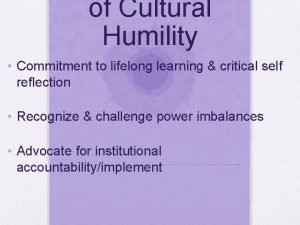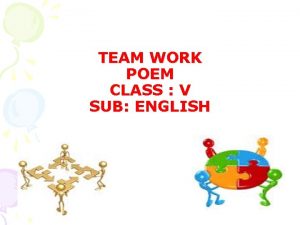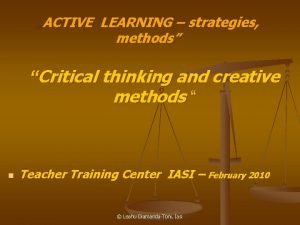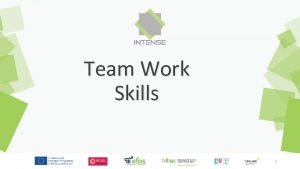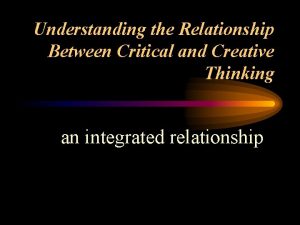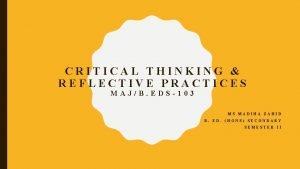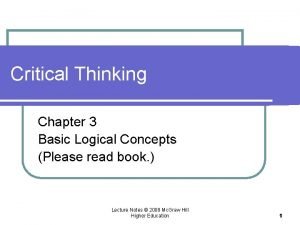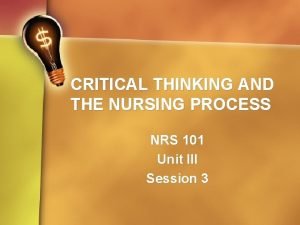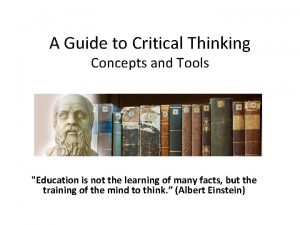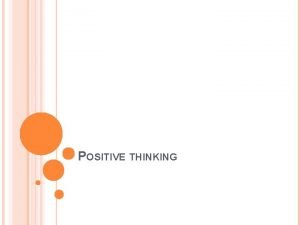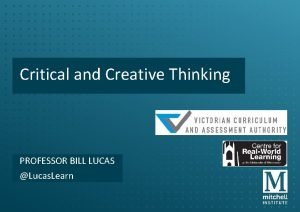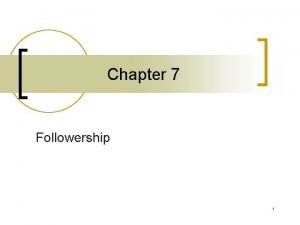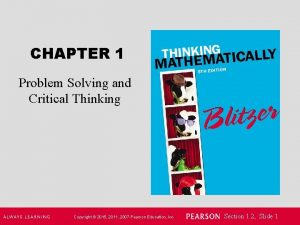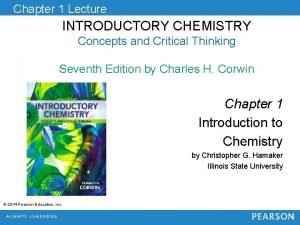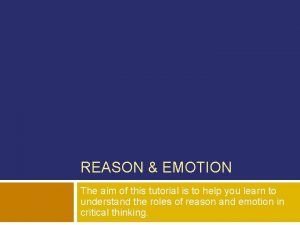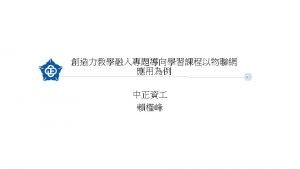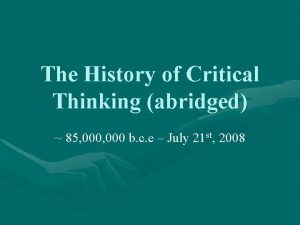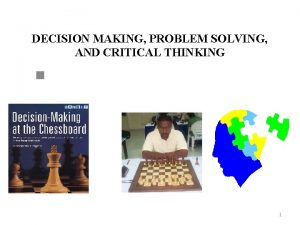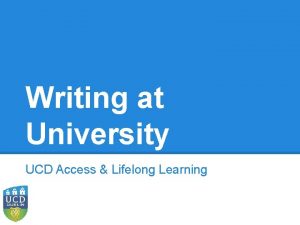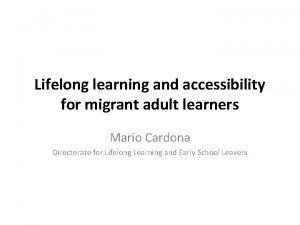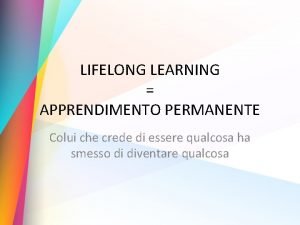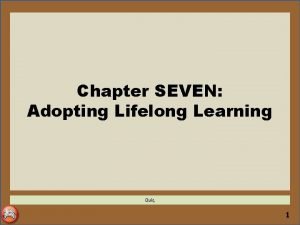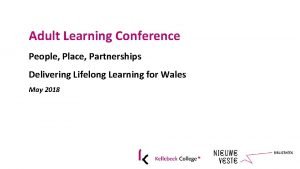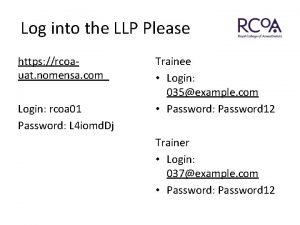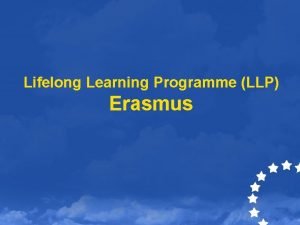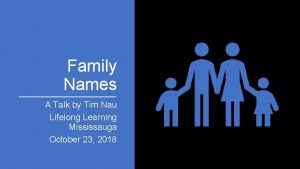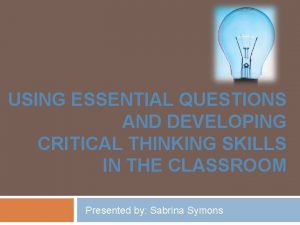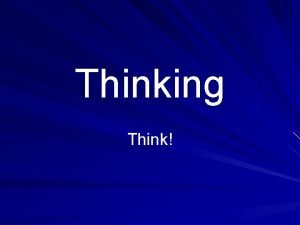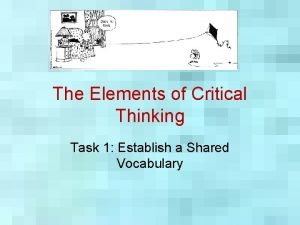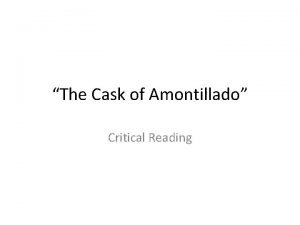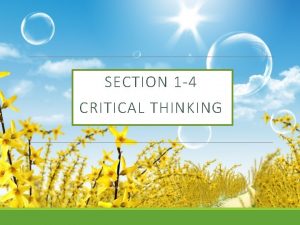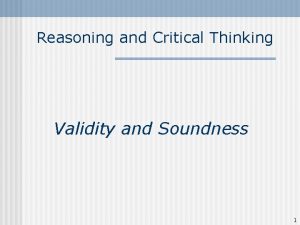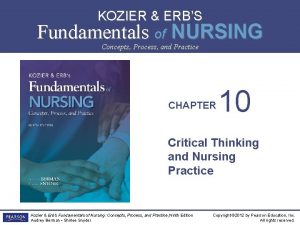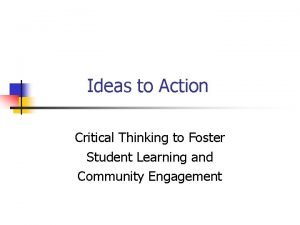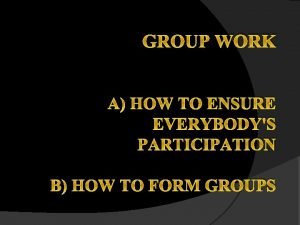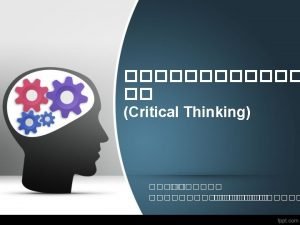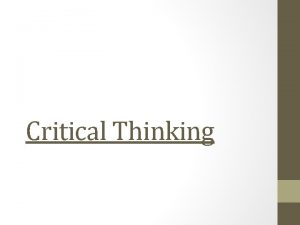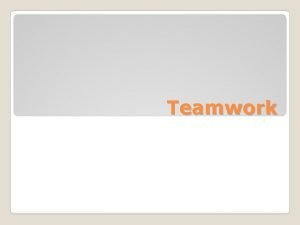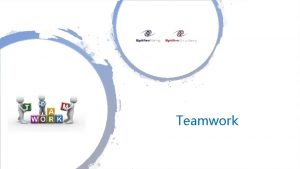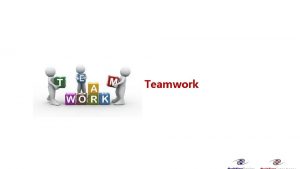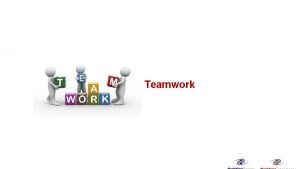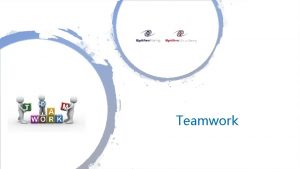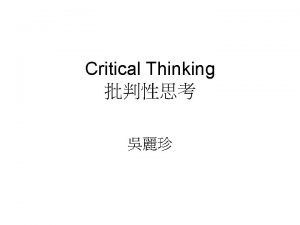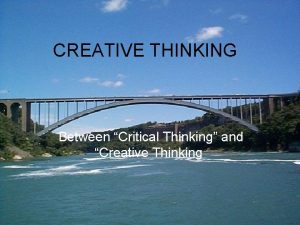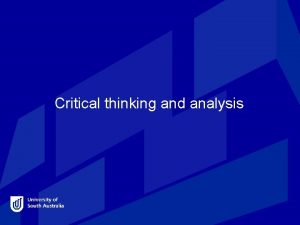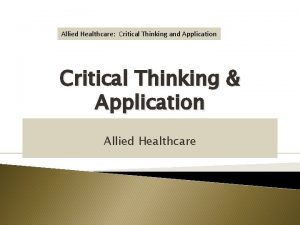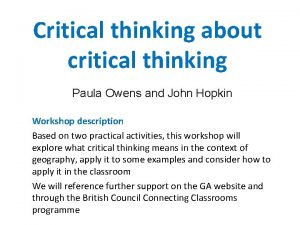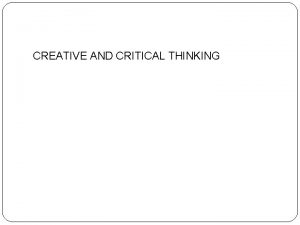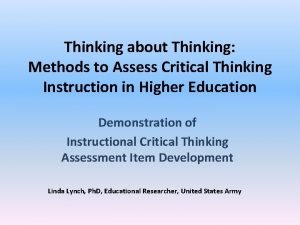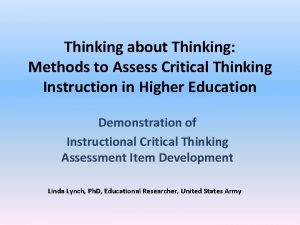Lifelong Learning Teamwork and Critical Thinking 1 Lifelong






















































- Slides: 54

Life-long Learning, Teamwork and Critical Thinking 1

Life-long Learning 2

AACSB: Life-long learning: preparation for life-long learning. ABET: Life-long learning: a recognition of the need for, and an ability to engage in life-long learning CEAB: Life-long learning: An ability to identify and to address their own educational needs in a changing world in ways sufficient to maintain their competence and to allow them to contribute to the advancement of knowledge. Dartmouth Medicine: Life-long learning: learn and adopt a structured approach to lifelong updating of knowledge and skills. 3

Activity What does life-long learning mean to you? In your teams, come up with a short defintion 4

• Understand what they need to learn • Evaluate their prior knowledge and identify gaps • Develop strategies for learning what they need • Monitor, reflect and adjust their learning strategies 5

Regulation Awareness Experience Metacognition 6

Metacognition Survey 7

Declarative Knowledge Procedural Knowledge Metacognition Awareness Conditional Knowledge 8

Planning Monitoring Metacognition Regulation Evaluating 9

Previous Successes Metacognition Experiences Previous Failures Responses to Task Difficulty 10

Activity Thinking about our courses and opportunities to show life-long learning/metacognition steps students are already taking 11

Take Away Thinking of where your students are already doing these kinds of strategies Change your assignments and activities to make the process more visible 12

Take Away Importance of modeling and reminding students of effective life-long learning behaviours 13

Teamwork 14

Product vs. Process 15

Ad hoc teams, short activities, very low accountability • Collaborative Learning (Buzz groups, think-pairshare, jigsaws) • Peer Instruction (Mazur) • Classroom Assessment Techniques (Angelo) Outcomes: focus on classroom engagement, feedback for instructor to adapt instruction on the fly 16

Small teams, longer projects, intricate individual accountability, often product focused • Cooperative Learning Outcomes: focus on product, instructor grade on team product, and very limited team process information, since task structures are designed to control teaming behaviours (i. e. minimizing bad behaviours). 17

How can we understand the stages teams go through? Tuckman’s (1965) • • Forming Storming Norming Performing 18

Large permanent teams, high accountability, often process focused • Case Based Learning • Problem Based Learning • Team-Based Learning Outcomes: focuses on process, often makes output of team thinking visible, creates strongly interdependent teams, students are in a good position to provide information about team process (often via peer evaluation). 19

What do high performance teams have that is so special? • Cohesion - requires time • Shared Vision and Goals • Interdependence - sense of duty to each others success and team success • Mutual respect and trust – respect individuals strengths and weakness • Efficient Communication - early in team development there is a large social overhead to discussions as people learn how to most effectively communicate with each other 20

Common measures of teamwork Common product measures – are team grades for some kind of artifact (report, video, poster) or some performance (presentation). The assigned grades can be tempered by using a peer evaluation process to more fairly distributed grade based on individual contribution to team product. Common process measures – are peer and self evaluation scores, learning journals, and reflections. Accreditors are most often interested in this one 21

A cautionary note from AACSB Collective work from a student team does not provide a basis to assess individual student performance and outcomes except where teamwork is a learning goal. In that case the collective work of the team may provide a basis for assessing performance as a team member. 22

Defining Peer Evaluation Criteria Activity 23

Critical Thinking 24

Activity What is Critical Thinking? 25

Critical thinking is characterized as a comprehensive, systematic, and methodical approach to investigating, analyzing, interpreting an issue, situation, or problem. 26

Critical Thinking • Identifies relevant information • Identifies missing information • Surfaces assumptions and biases • Recognizes when inferences are needed • Examine issue from multiple perspectives • Recognizes the influence of context Where can we build opportunities in our courses for our students to develop and use CT skills? 27

Where do our students get stuck on the way to becoming Critical Thinkers? 28

Perry Framework for Cognitive Development Dualism • Black and White world • Single correct answer • Teacher is authority Relativism • Everyone is entitled to their opinion, marking is subjective • Teacher is not longer authority • Must search elsewhere for correct answer Multiplicity • Some opinions are better than other • Begins evaluate evidence to support claims • Use evidence and reasoned argument to commit to a reasonable position Commitment 29

Facilitation for Deeper Discussion Critical Thinking 30

General Facilitation Moves Listening: (letting participants know they are being “heard”) Repeating and Clarifying Gesturing and non-verbal Probing and Elaborating Paraphrasing Summarizing Recording Processing: (helping participants learn how to step back from their ideas and “think” about them) Transitioning and Linking Challenging Acknowledging Evaluating Informing Interrupting 31

Critical Thinking Facilitation Moves • Which information is relevant? • What information is missing? • What assumptions are we making? • What decisions will we have to make with incomplete information? • Why do other people feel different about this issue? • Can we apply what we learn here to other situations? 32

What is ORID? An important discussion framework that has 4 stages that helps us have a systematic and comprehensive discussion • Objective Stage • Reflective Stage • Interpretive Stage • Decisional Stage 33

ORID - Objective Stage • Establish the facts • Agree on the data • Established a shared view of how we perceive the “facts” What is this? What do you see? What happened? What are the main ideas/points? What words or phrases really stand out? What recommendations were made? Where would you like to have more information? What information would you like to verify? What are the different aspects of the problem? What assumptions are being made? 34

ORID - Reflective Stage • Get personal reactions to the issue out in the open • Surface beliefs and attitudes • Hear personal internal responses What do you agree with? Where did you most identify with reading? Where did you feel convinced? What ideas intrigued you? Where were you surprised? What do you disagree with? What part of this makes you mad? Where did you feel uneasy? What should concern us? What do you acknowledge as necessary, but don’t like? Where did you reconsider a previous belief? Have you dealt with this kind of situation in the past? 35

ORID - Interpretive Stage • Search for meaning • Establish what is significant (values at play) • Establish what is not significant What is the real intent of…? What was this really about? What should we learn from this? What is the insight? What did you learn that you didn’t know before? What would be the advantages/disadvantages? What is the significance of this? What came through to you as very important? What difference will this make? What will this accomplish? What effects will these changes have? Who else will be affected? How could we use it? What will we need to do differently? 36

ORID - Decisional Stage • Seeking resolution • calls to actions, and considering future implications. We are trying to bring the conversation to a powerful close What is the real intent of…? What was this really about? What should we learn from this? What is the insight? What did you learn that you didn’t know before? What would be the advantages/disadvantages? What is the significance of this? What came through to you as very important? What difference will this make? What will this accomplish? What effects will these changes have? Who else will be affected? How could we use it? What will we need to do differently? 37

Facilitation Moves using ORID Listening: (letting participants know they are being “heard”) Repeating and Clarifying Gesturing and non-verbal Probing and Elaborating Paraphrasing Summarizing Recording Processing: (helping participants learn how to step back from their ideas and “think” about them) Transitioning and Linking Challenging Acknowledging Evaluating Informing Interrupting 38

Lunch 39

Effective Team Task Design 40

Effective task design for the TBL classroom Bill Roberson and Billie Franchini Journal on Excellence in College Teaching A+ 41

Quick Reading Review 5 -10 minutes 42

Readiness Assurance Process 43

You are creating a TBL team task for a writing course. You are considering different ways of wording the task. You want the activity to really make the students think and want it to lead to a deep discussion. Which of the following wordings for the task would likely best achieve these objectives? A. List the mistakes writers frequently make that detract from their efforts to write in an active voice. B. Read the following passage and identify clear examples of active voice and passive voice. C. Read the following passage and identify the sentence in which the passive voice is used most appropriately. 44

You are designing a sequence of team tasks that build on one another. You are trying to get the mix of abstract concepts and concrete experiences just right. How would you recommend the progression of activities across the module be structured. A. Start with simple abstract tasks and build to complex abstract tasks B. Start with simple concrete tasks and build to complex concrete tasks C. Start with simple abstract tasks and build to complex tasks that increasingly need the progression of concrete experience to complete D. Start with simple concrete tasks and build to complex tasks that increasingly need abstractions to solve/understand 45

How we facilitate a reporting conversation can change how effective the learning outcomes are. We want to help students build critical arguments by making sure that they examine different points of views, and identify assumptions, inconsistencies, and missing information that can affect the validity of their particular conclusion. How best can we help students build these critical arguments in the reporting discussions? A. You should carefully script and carefully control discussion so main points are always covered B. You should prepare critical thinking questions that can be used to extend and deepen the discussion as needed C. Since students responsibility for their learning, they are also responsible for getting the most out of the discussion 46

You are designing a discussion plan to manage the reporting conversation after a 4 S report. You want to avoid a sequential debrief, since you been told by Bill not to do this. Which of the following is most important? A. Start with a team that chose the minority position B. Let each team completely explain all their rationales so we can see the entire thinking process C. Limit each team to making just one point before moving on to next team D. Go back and forth between contrasting positions; work your way around to every team at least once. But always start with a team that has picked the right answer. 47

You been having trouble with a few teams rushing ahead and getting all the team tasks completed long before the other teams. They get bored, start off-task conversations, and have become quite disruptive to the students that are still working. What would be the best way to fix this problem? A. Hand out sub-tasks one at a time so teams can’t rush ahead B. Talk with fast teams and quiz them about the depth of their analysis and push them to further discuss their decisions C. Create a sponge activity that fast teams can work on if they finish the team task early. D. Display a timer and continuously keep informing teams where they should be in the progression of tasks 48

We should strive to design tasks that lead students through a complete thought process. How best can we structure these kinds of sequences? A. Give teams a worksheet that outlines several tasks at once, so they can divide up the tasks for efficiency. B. Give teams tasks one at a time, so dividing up the task makes no sense C. Assign earlier decisions in sequence as individual work to be completed before class. D. Assign individual preparatory work to be ready for the in-class decision-making task 49

You have adopted Team-Based Learning. You have been using the 4 S framework to structure your classroom problem-solving activities. You are pleased with the engagement and depth of discussion you are getting from your students, but are a bit concerned that the time spent on the activities are taking away from other aspects of the course. You are considering various options for overcoming this problem. Which option would you choose to fix this problem? And why? A. Make all module activities a bit simpler. Simplify the problems so the depth and complexity of analysis required is less for teams to arrive at a reasonable, defensible decision. B. Do fewer activities across the module. C. Reduce discussion time before simultaneous report. Give students a shorter time to discuss the problem inside their team, before publicly reporting their decision, since most rationales and arguments will come out in whole class discussion. D. Reduce discussion time after simultaneous report. Be more directive during the whole class discussion after the simultaneous report, so all the “important points” are more quickly covered. 50

Examining the anatomy of a good task that deepens learning and fosters critical discussions 51

You are head of Engineering for a large dam project on the Yellow river in the Ningxai province of China. The dam is to be located in the Yiling district near the exit of the Ordos Loop section of the river. The dam is to be located at 34° 49′ 46″N 111° 20′ 41″E. See attached diagram for specific site location and channel placement. The Yellow river is China’s third largest river. The local bedrock is a highly fractured gneiss. The river is characterized by very high silt loads. The proposed dam will be a concrete arch design. You have been asked to determine some of the main design parameters, including safety related question like what flood event return period to build the dam to withstand. What would return period you recommend the dam be designed to withstand? A. B. C. D. once in 50 year flood once in 100 year flood once in 200 year flood once in 500 year flood 52

Questions Next Steps Calls to Action 53

Thank You jim. sibley@ubc. ca learntbl. ca 54
 Lifelong learning and critical self-reflection
Lifelong learning and critical self-reflection Critical semi critical and non critical instruments
Critical semi critical and non critical instruments Semi-critical
Semi-critical Poem on teamwork
Poem on teamwork Perbedaan critical thinking dan creative thinking
Perbedaan critical thinking dan creative thinking Active learning strategies to promote critical thinking
Active learning strategies to promote critical thinking Active learning strategies to promote critical thinking
Active learning strategies to promote critical thinking Teamwork learning objectives
Teamwork learning objectives Teamwork learning objectives
Teamwork learning objectives Relationship between creative and critical thinking
Relationship between creative and critical thinking Nursing process and critical thinking
Nursing process and critical thinking Critical thinking and reflective practices
Critical thinking and reflective practices Logic and critical thinking chapter 2
Logic and critical thinking chapter 2 Common patterns of inductive reasoning
Common patterns of inductive reasoning Critical thinking in nursing
Critical thinking in nursing Critical thinking concepts
Critical thinking concepts Critical thinking positive and negative
Critical thinking positive and negative Critical and creative thinking victorian curriculum
Critical and creative thinking victorian curriculum Professor bill lucas
Professor bill lucas Independent critical thinking
Independent critical thinking Chapter 1 problem solving and critical thinking
Chapter 1 problem solving and critical thinking Introductory chemistry concepts and critical thinking
Introductory chemistry concepts and critical thinking Emotions and critical thinking
Emotions and critical thinking An introduction to critical thinking and creativity
An introduction to critical thinking and creativity Critical thinking history
Critical thinking history Nonmalefiscence
Nonmalefiscence Lifelong learning essay conclusion
Lifelong learning essay conclusion It is a lifelong process of social interaction.
It is a lifelong process of social interaction. Lifelong learning malta
Lifelong learning malta What is adopting lifelong learning
What is adopting lifelong learning Lifelong learning cos'è
Lifelong learning cos'è Educamos cdb
Educamos cdb Adopting lifelong learning
Adopting lifelong learning Lifelong learning assessment
Lifelong learning assessment Lifelong learning conference 2018
Lifelong learning conference 2018 Lifelong learning cartoon
Lifelong learning cartoon Rcoa llp
Rcoa llp Erasmus lifelong learning programme
Erasmus lifelong learning programme Lifelong learning mississauga
Lifelong learning mississauga Cuadro comparativo e-learning b-learning m-learning
Cuadro comparativo e-learning b-learning m-learning Critical reading meaning
Critical reading meaning Which is the hardest
Which is the hardest Critical thinking guidelines
Critical thinking guidelines Critical thinking examples
Critical thinking examples Critical thinking in daily life
Critical thinking in daily life Elements of critical thinking
Elements of critical thinking Medoc definition cask of amontillado
Medoc definition cask of amontillado Critical thinking examples
Critical thinking examples Validity in critical thinking
Validity in critical thinking Nursing inferences examples
Nursing inferences examples Five elements of critical thinking
Five elements of critical thinking Critical thinking icebreakers
Critical thinking icebreakers Critical thinking in group work
Critical thinking in group work Discussion questions for fahrenheit 451 part 1
Discussion questions for fahrenheit 451 part 1 Critical thinking definition
Critical thinking definition
